დამიანედამიანე, XIV საუკუნის ქართველი მხატვარი. ხელმძღვანელობდა უბისის ეკლესიის მოხატვას. აღნიშნული ძეგლის კედლის მხატვრობაში ფერწერის ორი მანერა შეიმჩნევა, ერთი, რომელიც ეკლესიის მხატვრობაში ჭარბობს, "საიდუმლო სერობის" კომპოზიციისათვის არის დამახასიათებელი; ამ სცენის ქვემოთ დამიანეს წარწერაა, რაც გვაფიქრებინებს, რომ "საიდუმლო სერობის" ფერწერული სტილი დამიანემ შექმნა; მეორე, როგორც ჩანს, მისი მოწაფის მიერაა შექმნილი. დამიანეს მიერ შესრულებული ფრესკები XIV საუკუნის ქართველი მხატვრობის უმნიშვნელოვანეს ძეგლთაგანია, ადრინდელი მხატვრობის მონუმენტურობას, სიდინჯესა და დარბაისლობას აქ დინამიკურობა, დაგრძელებული ფიგურები, სამოსლის ნაკეცთა რთული, ტეხილი ხაზები დაქუცმაცებული ხუროთმოძღვრული ფონი ცვლის. დამიანეს ნახატი მეტყველია, მის ენერგიულ ფერწერას ახასიათებს ფართო, თამამად დადებული ჭარბი მონასმები. მოციქულთა, ანგელოზთა და წმინდანთა სახეები ძალზე საინტერესოა თავისი ექსპრესიით. თმა და წვერი ოსტატურად არის დამუშავებული. "საიდუმლო სერობის" კომპოზიცია გვიჩვენებს, რომ მხატვარი არ ერიდებოდა რეალური სინამდვილის ასახვას - გაშლილ სუფრაზე აწყვია მწვანილი, ქართული პური. დამიანე თავისი დროის დიდი მხატვარი იყო.
http://ka.wikipedia.org/wiki/დამიანედამიანეს ფრესკებიMy Webpageუბისი"უბისას მონასტრის ხატები და კედლის მხატვრობა - XIVს."
უბისის ეკლესიის ხატწერისა და მონუმენტური ფერწერის ძეგლები ქართულ საეკლესიო ძეგლთა შორის სრულიად განსაკუთრებული მნიშვნელობისაა. მხატვრული დონითა და შინაარსობრივი დატვირთვით ეს უნიკალური ანსამბლია, რომელიც ერთდროულადაა შექმნილი ადგილობრივ სამხატვრო ამქარში გვერდიგვერდ მოღვაწე ხატმწერებისა და მონუმენტალისტების მიერ.
წიგნი "უბისას ეკლესიის ხატები და კედლის მხატვრობა _XIVს." (ავტორი ნ. ბურჭულაძე)
About Ubisi
'Ubisi' (Georgian უბისი) is a small village and a medievаl monastic complex in Georgia, particularly in the region Imereti, some 25 km from the town Kharagauli. The monastic complex of Ubisi comprises a 9th-century St. George’s Monastery founded by St. Gregory of Khandzta, a 4-floor tower (AD 1141), fragments of a 12th-century defensive wall and several other buildings and structures. The monastery houses a unique cycle of murals from the late 14th century made by Damiane apparently influenced by art from the Byzantine Palaiologan period (1261-1453). The monastery is also known for its honey made by the monks.
001.jpg) My Webpage
My Webpageეს კი ქართველი არქიტექტორის, აწგარდაცვლილი ვიქტორ ჯორბენაძის საიტიდანაა
Damiane's Murals at Ubisi Ubisi on the border between Imereti and Migrelia, off the road from Kutaisi to Zestaphoni, is not a well-known place and yet the church and its monastery go back to the 9th century, and the church houses a unique cycle of murals from the late 14th century which rival the best paintings in the Byzantine churches of Istanbul.
Although the painter's name, Damiane, is known, the accurate dating of his murals are in dispute. Because of their obviously non-Georgian style and their colors I venture to contradict the Georgian art-historian Shota Amiranashsvili's claim that the paintings are Georgian and suggest that Damiane came from Konstantinopolis during the last years before the fall of the city in 1428. It is also rare that the name of a Georgian church painter is known. I know of only two other examples: Cyrus Emanuel Eugenicus (also written Evgenika) who was hired from Konstantinopolis in 1384-96 by the Dadiani to paint in Tsalentsikha, and, of course, Tevdore and his disciples in Svaneti. The Damiane paintings have no relatives in Georgia but much in common with those of the Kariye Ecclesia in Istanbul and the paintings of other Konstantinopolian refugees in Crete and Greece. - I think for instance of El Greco's Cretan teacher. - I welcome comments by Brigitta and Rolf Schrade and other scholars of this subject.

Symbols of the Trinity in the vault of the church. The elegant hair-style of God Father and the cabalistic rhomb winged by a Tetramorph! To the left is the Annunciation pictured below and to the right the Nativity also shown further down.

The almost aggressively dramatic angel of the Annunciation.
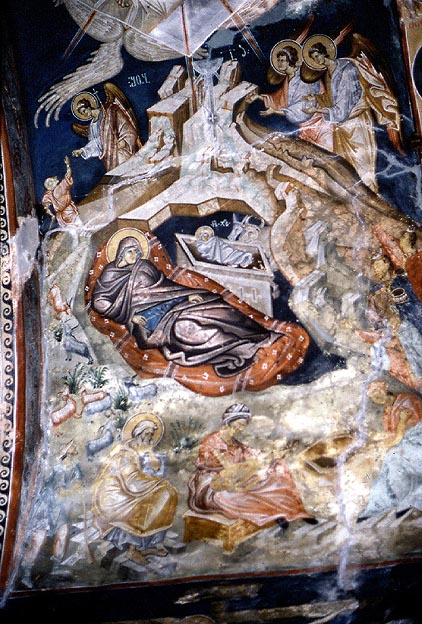
Less well preserved than the Trinity the depiction of the Mother of Christ adheres to traditional Eastern Byzantine models, but it is surrounded by scenes in a pastoral landscape more turbulent than even contemporary Tuscan paintings. The washing of the child below the Three Kings to the right.
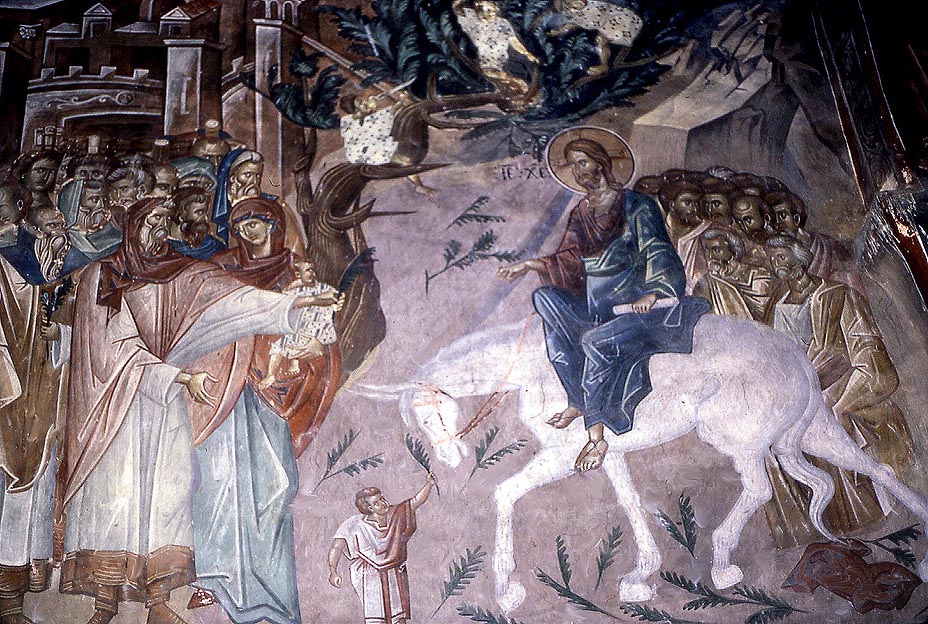
Christ's entry into Jerusalem. Christ in off-blue is nonchalantly enthroned on a tired white donkey, the children hacking-off palm branches and especially the two dramatic crowd-scenes with their massed together people and individualized facial features (the man on the left holding out a palm leaf!) are highly refined. What and where are the models of Damiane?
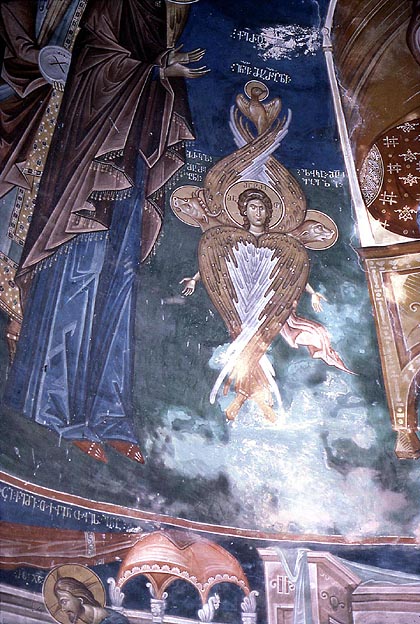
The Great Tetramorph and an over-elongated saint reminiscent of El Greco... what minerals did Damiane use to prepare his blues?
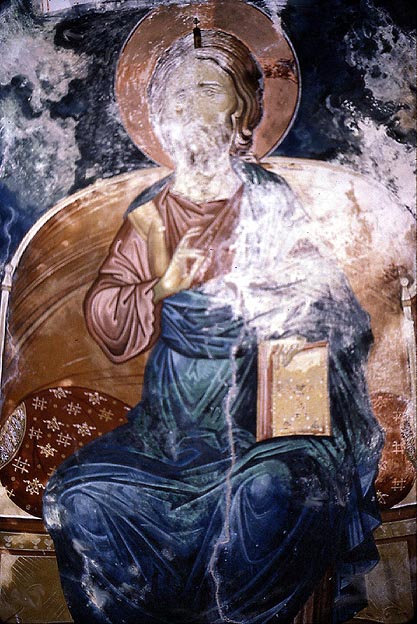
Christ in Majesty in the apse conch....
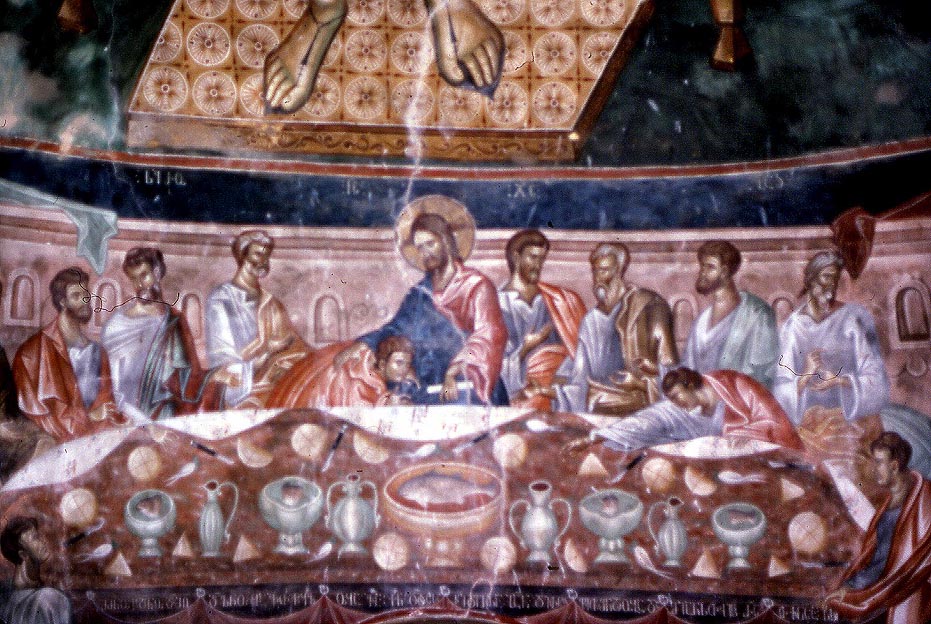
....and below his feet the Last Supper, an unusual location for Georgia and Byzantine painting. - The disciples have no halos and an eleventh disciple is out of the picture to the left. But Judas sits at his conventional place in the left foreground on a stool. Unfortunately this photo is not sharp...
http://vdjorbenadze.tripod.com/Ubisi/Ubisi.htmსაფლავის ქვა უბისიდან (ფოტოს ავტორი: ვიქტორ ჯორბენაძე, 1984 წელი)
მიმაგრებული სურათი

ეს რამხელა, რა უძირო და რა გამძლე გამოდექ, ჯოჯოხეთის დამტეველო, პაწაწინა სამოთხევ
http://geosons.blogspot.com/


